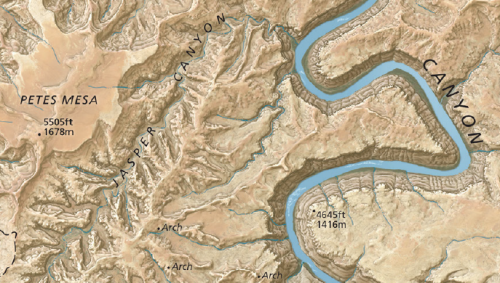Beautiful maps are not the preserve of a bygone era when people spent years surveying, then designing and producing their map. While that has often led to some spectacular and often unparalleled cartography, modern techniques are no less capable of producing similarly impressive work.
Here, Tom Patterson, inspired by the map of the Heart of the Grand Canyon by Bradford Washburn (MapCarte 100) sets out to create an equally impressive representation using modern data, software and processing. He achieves it with ease in the sense that the finished product provides an exquisite depiction of the terrain morphology and colours of the landscape. Patterson uses a range of techniques to build a realistic rendering of the terrain that captures not only the vertical component but also something of the horizontal structure and bedding that the hillshading techniques yield. In particular, the techniques used give an impression of rock texturing synonymous of historic, manually drawn relief and rock shading typical of the Swiss school of cartography. Patterson successfully and impressively gives us a realistic and engaging three-dimensional landscape.
 Rather than leave the map as a function of processed digital elevation models, Patterson goes further in attempting to give a realistic rendering. Thee colours are derived from a process that combines aerial photography with the relief renderings. This allows natural colours to play a part in colouring the map though there is some additional exaggeration of colours such as blue for water features to make them sit comfortably and boldly in the landscape.
Rather than leave the map as a function of processed digital elevation models, Patterson goes further in attempting to give a realistic rendering. Thee colours are derived from a process that combines aerial photography with the relief renderings. This allows natural colours to play a part in colouring the map though there is some additional exaggeration of colours such as blue for water features to make them sit comfortably and boldly in the landscape.
Overall, a combination of advanced digital terrain model processing, some clever compositing with aerial photography and a keen eye to manually adjust what’s required give the map the finished look. It’s a beautiful depiction and harks not only to a bygone era of care in terrain representation but also to a future when we should strive to achieve such a wonderful result in our mapping.
You can download a high resolution version of the map here and it’s featured in the NACIS Atlas of Design Volume II.

